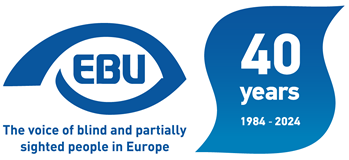Statistics
- There are estimated to be over 30 million blind and partially sighted persons in geographical Europe (see details).
- An average of 1 in 30 Europeans experience sight loss.
- There are four times as many partially sighted persons as blind persons.
- The average unemployment rate of blind and partially sighted persons of working age is over 75 percent.
- More women are unemployed than men.
- Women are more at risk of becoming blind or partially sighted than men.
- Sight loss is closely related to old age.
- One in three senior citizens over 65 faces sight loss. 90 percent of visually impaired persons is over the age of 65
Details concerning statistical information
The World Health Organisation estimates, in figures dating from 2010, that in Europe there are
- 2,550,000 blind people and
- 23,800,000 low vision people, giving a total of
- 26,350,000 visually impaired individuals.
This information and further data is available on the WHO website
EBU tends towards an estimate of 30,000,000 visually impaired individuals. This higher figure takes into account the prevalence of sight-loss amongst an increasing population of elderly people in Europe which is extremely difficult to accurately quantify, and also the fact that there exists a number of people who suffer from varying degrees of sight loss but who either ignore this or decide for personal reasons not to declare their condition.
Causes of sight loss
Some people are born with reduced sight whilst others may acquire an eye condition later in life, such as retinitis pigmentosa that deteriorates with age. Others may lose their sight in an accident, or because of a disease like diabetes or arthritis.
Age-related eye conditions are the most common cause of sight loss in Europe. Eyesight in seniors may be affected by conditions such as macular degeneration or cataracts.
In the poorer countries of the world millions of people suffer sight loss caused by preventable diseases. These types of vision loss are called ‘preventable blindness'.
Definitions
The definitions of blindness and partial sight, as well as the registration criteria vary from one European country to another.
EBU adopts in principle the definitions used by the World Health Organisation (WHO) for blindness and partial sight. At the same time EBU advocates the importance of using the so called 'functional sight' parameters in addition to the WHO definitions when determining the support a blind or partially sighted person needs.
The term ‘visual impaired' is used to indicate blind plus partially sighted people together.
Partially sighted and low vision are used as equal indication of limited sight.
See also the statement on the need to use the right definitions and terminology in standardisation work.
Other criteria generally used by ophtalmologists:
- A person can register as blind if they can only read the top letter of the optician's eye chart from three metres or less.
- A person can register as partially sighted if they can only read the top letter of the chart from six metres or less.
Deafblindness (External link) is a condition that combines in varying degrees both hearing and sight loss. Two sensory impairments multiply and intensify the impact of each, creating a severe disability with a high risk of isolation and exclusion. Deafblindness is different and therefore requires specific actions and solutions.
Living with sight loss
People with sight loss are from all walks of life, have different backgrounds, education and social status. The way in which each individual is affected, is highly unique and can be a totally difference experience from one person to the other. Support, rehabilitation, social benefit system are some of the factors that make coping with sight loss easier.
A common misconception is that blind persons cannot see anything at all. This is of course true for some, while many have some perception of light and shadow, see everything in a vague blur, have tunnel vision, or lack central vision. There are many different eye conditions and they all produce a different form of vision distortion.

